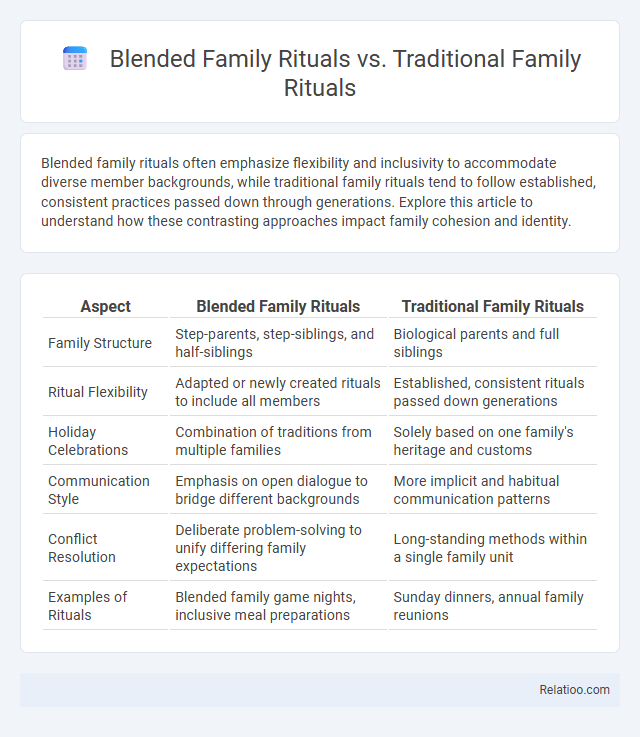Blended family rituals often emphasize flexibility and inclusivity to accommodate diverse member backgrounds, while traditional family rituals tend to follow established, consistent practices passed down through generations. Explore this article to understand how these contrasting approaches impact family cohesion and identity.
Table of Comparison
| Aspect | Blended Family Rituals | Traditional Family Rituals |
|---|---|---|
| Family Structure | Step-parents, step-siblings, and half-siblings | Biological parents and full siblings |
| Ritual Flexibility | Adapted or newly created rituals to include all members | Established, consistent rituals passed down generations |
| Holiday Celebrations | Combination of traditions from multiple families | Solely based on one family's heritage and customs |
| Communication Style | Emphasis on open dialogue to bridge different backgrounds | More implicit and habitual communication patterns |
| Conflict Resolution | Deliberate problem-solving to unify differing family expectations | Long-standing methods within a single family unit |
| Examples of Rituals | Blended family game nights, inclusive meal preparations | Sunday dinners, annual family reunions |
Introduction to Family Rituals: Blended vs. Traditional
Family rituals serve as essential bonding practices that foster stability, identity, and emotional connection among members. Blended family rituals often incorporate unique traditions that merge diverse backgrounds, promoting inclusivity and adaptability. Traditional family rituals typically emphasize long-standing customs and structured routines, reinforcing generational values and continuity.
Defining Blended Family Rituals
Blended family rituals are unique traditions created to unite members from different biological families, fostering a sense of belonging and stability within the new family structure. Unlike traditional family rituals that often stem from long-established customs and shared history, blended family rituals emphasize inclusivity, flexibility, and adaptation to accommodate diverse backgrounds and schedules. Your ability to establish meaningful blended family rituals supports emotional bonding and helps create a cohesive family identity despite the complexities of step-parenting and co-parenting dynamics.
Core Elements of Traditional Family Rituals
Core elements of traditional family rituals include consistent routines, shared values, and symbolic activities that reinforce family identity and cohesion. Unlike blended family rituals, which often require adaptation and negotiation among members, traditional rituals emphasize continuity and stability passed down through generations. Your understanding of these core elements helps preserve cultural heritage and strengthens emotional bonds within the family unit.
The Role of Rituals in Family Bonding
Family rituals, including blended family rituals and traditional family rituals, play a crucial role in strengthening family bonds by creating consistent opportunities for shared experiences and emotional connection. Blended family rituals often involve adapting or creating new traditions that respect the dynamics of step-relations, enhancing cohesion and identity among family members. Traditional family rituals, such as holiday celebrations and weekly dinners, reinforce established roles and continuity, contributing to a sense of stability and belonging that supports long-term emotional well-being.
Ritual Adaptation: Challenges in Blended Families
Blended families face unique challenges in ritual adaptation due to differing traditions, parenting styles, and family dynamics compared to traditional families, which typically share a common cultural and historical background. These challenges often necessitate creating new, inclusive family rituals that respect each member's past while fostering unity and belonging within the blended family structure. Successfully adapting rituals requires flexibility, open communication, and sensitivity to each individual's needs to build a cohesive family identity.
Preserving Heritage through Traditional Rituals
Traditional family rituals play a crucial role in preserving cultural heritage by passing down customs, values, and stories through generations. Blended family rituals often blend diverse traditions to create unique, inclusive practices that honor multiple heritages while fostering unity. Your family ritual acts as a vital link to ancestral roots, ensuring that heritage remains alive and meaningful in a modern context.
Innovation and Flexibility in Blended Family Rituals
Blended family rituals emphasize innovation and flexibility, adapting traditional customs to accommodate diverse member backgrounds and schedules, unlike rigid traditional family rituals that follow set patterns. You can create personalized celebrations that strengthen bonds while respecting individual preferences, fostering inclusivity and harmony. This dynamic approach ensures rituals remain meaningful and relevant despite complex family structures or changing circumstances.
Impact of Rituals on Children’s Sense of Belonging
Blended family rituals create unique traditions that help children navigate complex family dynamics by fostering inclusion and identity within multiple family units. Traditional family rituals often provide consistent, predictable experiences that reinforce a strong sense of stability and belonging through shared values and history. Family rituals, in general, contribute significantly to children's emotional security and social development by promoting connection, continuity, and a collective family identity.
Navigating Conflicts Around Family Rituals
Navigating conflicts around family rituals requires understanding the unique dynamics of blended family rituals, which often involve integrating diverse traditions and creating new shared practices. Traditional family rituals focus on preserving long-standing customs that may feel exclusive or rigid to new members, potentially causing tension. Your approach should emphasize open communication and flexibility to honor both established customs and the evolving identity of your blended family.
Creating Meaningful Rituals for Modern Families
Creating meaningful rituals for modern families involves blending traditional family rituals with innovative blended family practices to foster unity and emotional connection. Blended family rituals prioritize inclusivity and adaptability, recognizing diverse family structures and emphasizing shared experiences that celebrate both new and established bonds. Traditional family rituals often focus on heritage and continuity, while modern approaches integrate flexibility to accommodate evolving family dynamics and multicultural values.

Infographic: Blended Family Rituals vs Traditional Family Rituals
 relatioo.com
relatioo.com